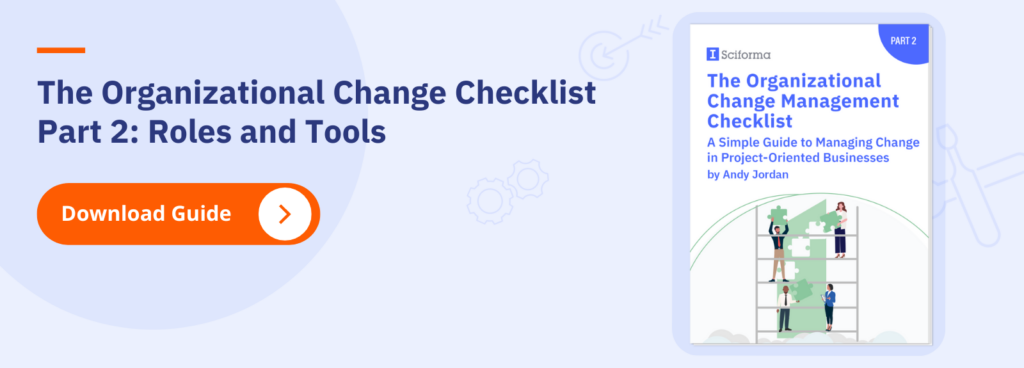- Home
- Blog Center
- Agile Approaches to Managing Different Types of Organizational Change
Agile Approaches to Managing Different Types of Organizational Change
In today’s world, organizational change cannot be an occasional discipline, nor can it treat each initiative in isolation. Change is constant, with one change acting as the springboard for the next, continuously adapting to an evolving operating environment. Approaches to all types of change management in the workplace—strategic, project, and organizational—must treat the change as a continuous way of managing an enterprise. That can only happen in an organization built to absorb and embrace change and change management, and follows certain best practices for managing organizational change.
Types of Organizational Change Management
Just as every project is unique, so is every organizational change initiative. However, there are some variations, generally based on scale and potential for disruption, that will impact how your business carries out that change management.
Changes to Teams or Work Areas
At the more straightforward end of the spectrum are those organizational changes confined to a single team or work area. These may relate to a new or improved process, an upgraded specialist technology solution designed to support an operational function, or similar. Here, organizational change can focus on just the one impacted team by providing them with:
- Training based on the different roles and responsibilities.
- Communication around what will be happening, why, how teams will be impacted, etc.
- Collaboration with teams and leaders to ensure the solutions are appropriate to their needs and business priorities.
Changes to Multiple Business Areas or Teams
Next in terms of complexity are organizational changes that impact multiple business areas or teams. These may be new products or services, where change is required in sales, marketing, customer service, finance, perhaps professional services, and so on. These require all the activities from the more straightforward organizational change above, but also need:
- Communication, collaboration, and understanding on how work will flow from one team to the next, the dependencies across teams, and so on.
- Support on integrating the change into current operations. While the simple examples often involve streamlining or changing current operations, these items are often overlays and additions. Teams must therefore receive support through managing workloads and capacity.
Enterprise-Wide Changes
The most complex form of organizational change is enterprise-wide transformation. These have become more common in recent years as businesses seek to reinvent themselves through the ability to leverage emerging technologies, Agile work methods, etc. These changes have the potential to be highly disruptive and, in addition to everything above, they require:
- Comprehensive engagement from organizational leadership to ensure that all business areas, teams, and individuals have a common understanding of purpose, timing, and impacts.
- As much transparency as possible on potential impacts on employment, development, and operational changes that will occur.
- Visibility into organizational roadmaps so teams understand how the transformative change is going to lead to additional changes, opportunities, and evolutions for them, the organization, and customers.
As the complexity of organizational change increases, it becomes more essential to ensure the integration of the function into other areas of the strategic portfolio. The easiest way to go about this is with the support of organizational change professionals with training and experience in the field. That can only happen when managing all strategic elements through an integrated software solution that supports the entire strategic lifecycle. Project portfolio management (PPM) solutions are a necessary tool for organizations seeking to provide this holistic approach to strategy delivery and organizational growth.

Agile Approaches to Managing Organizational Change in the Workplace
Remember what we said earlier about absorbing and embracing change? That’s where the idea of organizational agility comes in. Organizational agility is the concept of building an organization designed to adapt and evolve with changing circumstances. After all, change becomes an inherent part of what the enterprise is. Strategic plans evolve, investments shift and adjust with minimal disruption, and teams are empowered to shift their working methods to meet the needs of the business and its clients.
Organizational change management best practices are the key to making this work. They must operate as part of the strategic management of the business—anticipating upcoming impacts so that preparatory work can begin, recognizing the need to distribute change to avoid hotspots, and managing those changes in a way that acts as an enabler for business success.
When a business achieves this, managing change in the workplace becomes much easier. It is seen as a natural extension of how the organization operates. Employees are less concerned about change because they are operating in an environment and culture that both:
- acknowledges the importance of change to business success,
- works with those employees, their teams, and their departments, to plan and implement change management
Via these organizational change management best practices, individuals can contribute ideas and become part of the change process. As a result, they are given a much better insight into what their world is going to look like post-change.
Tools for All Types of Organizational Change Management
This more agile approach to managing organizational change in the workplace is a valuable tool. Organizations that can adopt it consistently, integrating change into how they operate and deliver on strategy, have much higher capacity for success. Both now and in the future. PPM solutions help with this process. They allow for the integration of change management into the rest of the strategic landscape. Further, they identify impacts and dependencies through comprehensive modeling and what-if capabilities. Critically, they can also act as communication hubs, ensuring consistent messaging is to all areas around what is happening and why. Accordingly, they provide a strong foundation for change to succeed.
To learn more about the roles, responsibilities, and tools required for successful organizational change, claim your copy of the Organizational Change Management Checklist today:








Andy Jordan
Andy Jordan is President of Roffensian Consulting S.A., a Roatan, Honduras based management consulting firm with a strong emphasis on organizational transformation, portfolio management, and PMOs. Andy is an in-demand keynote speaker and author who delivers thought provoking content in an engaging and entertaining style. He is also an instructor in project management-related disciplines, including PMO and portfolio management courses on LinkedIn Learning.